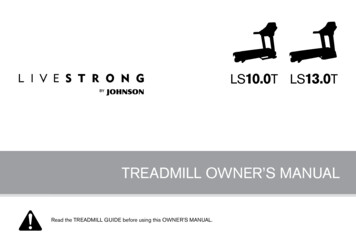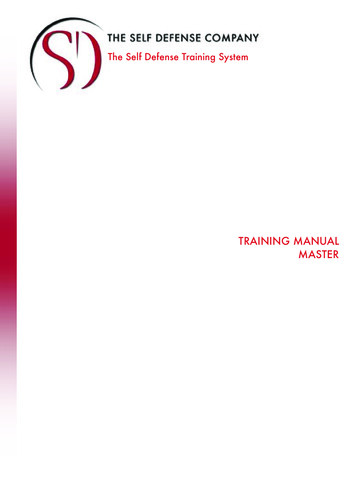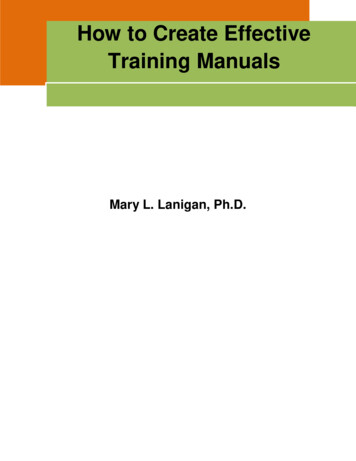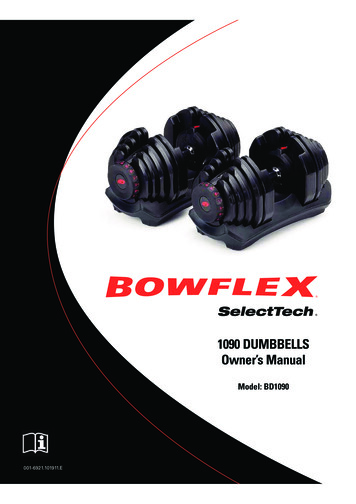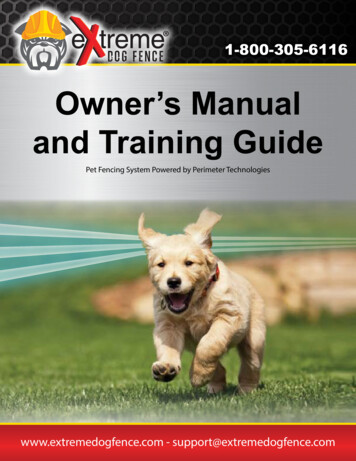
Transcription
1-800-305-6116Owner’s Manualand Training GuidePet Fencing System Powered by Perimeter Technologieswww.extremedogfence.com - support@extremedogfence.com
CONGRATULATIONSRegister Your NeweXtreme Dog Fence Containment System within 30 Days of PurchasetoActivate your 10 Year WarrantyYou will need the following information ready to register:1. Order #2. Date of Purchase3. Phone Number4. E-Mail AddressTo register, go to:www.extremedogfence.com/registerAnd follow the online directions.Thank you for your purchase, and welcome to the family.www.extremedogfence.com800-305-6116
Owner’s Guide1Owner’sGuideSAFETY INFORMATION1IMPORTANTExplanationof AttentionWords andSymbols Used in this GuideIMPORTANTSAFETYINFORMATIONExplanation of Attention Words and Symbols Used in this GuideThis is the safety alert symbol. It is used to alert you to potential personal injury hazards.Obeyisallsafetymessagesthat followthistosymbolto avoidpossiblepersonalinjury orinjurydeath.Thisthesafetyalert symbol.It is usedalert youto potentialhazards.!!Obey all safety messages that follow this symbol to avoid possible injury or death.WARNING indicates a hazardous situation which, if not avoided, couldresultin deathor seriousinjury. situation which, if not avoided, couldWARNINGindicatesa hazardousWARNINGWARNING! CAUTION! Gresult in death or serious injury.CAUTION, used with the safety alert symbol, indicates a hazardous situationwhich,if notavoided,couldresultin minoror moderateinjury.CAUTION,usedwiththe safetyalertsymbol,indicatesa hazardoussituation which, if not avoided, could result in minor or moderate injury.CAUTION, used without the safety alert symbol, indicates a hazardoussituationif not avoided,couldresultin harmto yourdog.CAUTION,which,used withoutthe safetyalertsymbol,indicatesa hazardoussituation which, if not avoided, could result in harm to your dog.NOTICE is used to address safe use practices not related to personal inNOTICE is used to address safe use practices not related to personal in !!CAUTIONCAUTION Not for use with aggressive dogs. Do not use this product if your dogis prone to aggressive behavior. Aggressive dogs can cause severeNotfororusewithtoaggressivedogs.andDo others.not use Ifthisyour thatdoginjurydeaththeir ownersyouproductare notif sureisproneto aggressivecanveterinariancause severethisproductis right for behavior.your dog, Aggressiveplease talk dogsto yourorinjuryor trainer.death to their owners and others. If you are not sure thatcertifiedthis product is right for your dog, please talk to your veterinarian orUndergroundcables can carry high voltage. Have all undergroundcertifiedtrainer.cables marked before you dig to bury your wire. In most areas, thisUndergroundcablescarryhighwhenvoltage.Have all undergroundis a free service.Avoidcanthesecablesyou dig.cables marked before you dig to bury your wire. In most areas, thisFollowsafety Avoidinstructionsfor yourpoweris a freeallservice.these cableswhenyoutools.dig. Be sure to alwayswear your safety goggles.Follow all safety instructions for your power tools. Be sure to r remove your system during a lightningstorm. If the storm is close enough for you to hear thunder, it isDonotinstall,toconnect,or removeyour system during a lightningcloseenoughcreate hazardoussurges.storm. If the storm is close enough for you to hear thunder, it isRiskelectrictoshock.the transmittercloseofenoughcreateUsehazardoussurges. in a dry location only.Risk of electric shock. Use the transmitter in a dry location only.Risk of injury. Wire on top of the ground may be a trip hazard. Usecare in how you place your wires.Risk of injury. Wire on top of the ground may be a trip hazard. UseIfpossible,anwires.AC circuit with a GFCI (ground fault circarein howDOyouNOTplaceuseyourcuit interrupter). In rare cases, nearby lightning may cause the GFCIIfDO NOTusetoancircuit yourwith doga GFCIcirtopossible,trip. WithoutpowertheACsystem,may(groundescape.faultYou ycausetheGFCIhave to reset the GFCI to restore power.to trip. Without power to the system, your dog may escape. You willhave to reset the GFCI to restore om800-305-6116800-305-6116
Owner’s Guide2 ContinuedCAUTION This eXtreme Dog Fence brand underground dog fence is NOT asolid barrier. The system is designed to act as a deterrent to reminddogs by stimulation to remain in the boundary established. It is important that you reinforce training with your dog on a regular basis.Since the tolerance level to stimulate varies from one dog to thenext, eXtreme Dog Fence CANNOT guarantee that the system will,in all cases, keep a dog within the established containment area.Not all dogs can be trained to avoid crossing the boundary. Therefore, if you have reason to believe that your dog may pose a dangerto others or harm himself if he is not kept from crossing the boundary, you should NOT rely solely upon the eXtreme Dog Fence brandunderground dog fence to confine your dog. eXtreme Dog Fence shall not be liable for any property damage, economic loss or anyconsequential damages, sustained as a result of any animal crossingthe boundary.Please read and follow the instructions in this manual. Proper fit of thecollar is important. A collar worn for too long or made too tight on thedog’s neck may cause skin damage. This could range from redness topressure necrosis (commonly known as “bed sores”.) Avoid leaving the fence collar on your dog for more than 12 hoursper day. When possible, reposition the collar on the dog’s neck every 1 to 2hours. Check the fit to prevent excessive pressure. Follow the instructionsin this manual. Never connect a leash to the electronic collar. This will cause excessive pressure on your dog’s neck, from the contacts. Use a separatenon-fence collar with the leash. Wash your dog’s neck and the collar’s contacts each week with adamp cloth. Examine the contact area daily for signs of a irritation or a sore. If a rash or sore is found, discontinue use of the fence collar untilthe skin has healed. If the condition continues beyond 48 hours, seeyour veterinarian. Keep your dog safely contained on a leash during training.These steps will help keep your dog safe and comfortable. Millions ofdogs are comfortable while they wear stainless steel or comfort contacts. Some dogs are sensitive to contact pressure. You may find aftersome time that your dog is very tolerant of the collar. If so, you may relax some of these precautions. It is important to continue daily checksof the contact area. If redness or sores are found, discontinue use untilthe skin has fully healed.You may need to trim the hair in the area of the contacts or switch tolonger contacts to ensure consistent contact. Never shave the dog’sneck; this may lead to a rash or infection.www.extremedogfence.com800-305-6116
Owner’s Guide3 ContinuedCAUTIONNOTICETo prevent an unintended correction: The collar receiver should not be on your dog when the system istested. Remove the collar receiver before making any changes to your system. Before placing the collar receiver on your dog, test the signal fieldafter any change. For added protection, when unused for long periods of time or priorto thunderstorms, unplug from the wall outlet and disconnect theboundary wires. This will prevent damage to the transmitter due tosurges.Avoid damage to the jacket of the loop wire during the install; Damage may cause areas of weak signal and lead to early failure of theloop (wire breaks).IMPORTANT! YOUR EXTREME DOG FENCE SYSTEM COMES WITH RUBBER TIPSFOR YOUR PET’S COMFORT CONTACTS. THE COMFORT CONTACT TIPS WILL LOSECONDUCTIVITY OVER TIME AND NEED TO BE CHANGED TO MAINTAIN THE PERFORMANCE OF YOUR FENCE COLLAR. IF USING THE RUBBER COMFORT CONTACTS, PLEASE CHANGE RUBBER TIPS WITH EACH COLLAR BATTERY CHANGE. ADDITIONAL RUBBER TIPS CAN BE PURCHASED AT WWW.EXTREMEDOGFENCE.COMNOTE: This equipment has been tested and found to comply with the limits for a Class B digital device, pursuant to Part 15 of the FCC rules. These limits are designed to provide reasonable protectionagainst harmful interference in a residential installation. This equipment generates, uses, and can radiate radio frequency energy and, if not installed and used in accordance with the instructions, maycause harmful interference to radio communications. However, there is no guarantee that interference will not occur in a particular installation. If this equipment does cause harmful interference toradio or television reception, which can be determined by turning the equipment off and on, the useris encouraged to try to correct the interference by one or more of the following measures: Reorient or relocate the receiving antenna Increase the separation between the equipment and the receiver Connect equipment to an outlet or a circuit different from that to which the receiver is connected Consult the dealer or an experienced radio / TV technician for helpCaution: Changes or modifications to any component, not expressly approved by eXtreme DogFence could void the user’s authority to operate this equipment.www.extremedogfence.com800-305-6116
Owner’s Guide4Congratulations!You have purchased the most comfortable and reliable pet fencing system for your cherished family pet. eXtreme Dog Fence Comfort Contact system was designed by theindustry’s most experienced team to provide years of worry-free freedom for both you and your pet.Simply follow the steps outlined in this user’s guide and your fence will be operational in no time.Should you have any difficulty along the way, help is available both by calling the Customer Care Centerat 1-800-305-6116, or by sending an E-mail message to support@extremedogfence.com.How the System WorksThe eXtreme Dog Fence containment system has been tested and proven safe, comfortable, and effective for dogs over 8 pounds. The system works by producing a radio signal from the fence transmitter boxthrough up to 5000 feet of 14 gauge boundary wire (2500 feet of 20 gauge). The boundary wire is laidout to encompass your dog’s play area, completing a closed loop from and back to the transmitter. Youtemporarily define the boundary with training flags, as a visual aid while training your dog. Your dogwears a collar receiver with contact points that touch your pet’s neck and, once trained, is allowed toroam freely inside the containment area you define. When your dog reaches the signal field emitted fromthe boundary wire, the collar receiver gives a warning beep. If you dog continues a short distance furtherinto the signal field (approximately 6 inches), a safe stimulation will be delivered through the contactpoints, signaling your dog to return to his containment area.Key TermsTRANSMITTER: The power source that transmits the radio signal through the wire loop.SIGNAL FIELD: The amount of warning/correction zone that is emitted from the wire in all directions.BOUNDARY WIRE: The wire that surrounds the area you encompass to keep your dog within.TWISTED WIRE: Two lengths of coupled wire that do not trigger the collar’s correction.GROUND WIRE: A length of wire you cut to be used as basic protection against lightning surges.WARNING BEEP: A warning tone the collar emits when it is within 6” or less of the correction zone.SURGE PROTECTOR: The lightning protection unit that sits between your transmitter and wire.COLLAR RECEIVER: The strap and oval unit that receives the radio signal from the boundary wire.CONTACTS: The retractable probes and rubber tip covered metal probes that connect to the receiver.FREQUENCY: The AM radio signal bands that the fence can be set to run on (7kHz and 4kHz).www.extremedogfence.com800-305-6116
Owner’s Guide5INCLUDED COMPONENTSStandard Grade Kit Boundary Wire (20 Gauge)Digital Transmitter (with Power Supply)Collar Receiver(s)1x Battery Per Collar1x Set of Medium Comfort Contacts Per Collar1x Set of Long Steel Contacts Per CollarTraining Flags (1 Per Each Foot of Boundary Wire)Waterproof Splice KitsTransmitter Mounting HardwarePro Grade Kit Boundary Wire (14 Gauge)Twisted Wire (16 Gauge)Digital Transmitter (with Power Supply)Dog Fence Surge ProtectorCollar Receiver(s)1x Battery Per Collar1x Set of Medium Comfort Contacts Per Collar1x Set of Long Steel Contacts Per CollarTraining Flags (1 Per Each Foot of Boundary Wire)Waterproof Splice Kits10x Yard StaplesTransmitter Mounting Hardwarewww.extremedogfence.com800-305-6116
Owner’s Guide6Table of ContentsImportant Safety Information1How the System Works and Key Terms4Included Components5At a Glance (Overview)7Step 1 - Planning Your Fence Layout9Step 2 - Selecting a Transmitter Location10Step 3 - Layout Your Wire and Make Connections11Step 4 - Testing Your Fence Operation14Step 5 - Securing Your Fence Wire15Step 6 - System Adjustments and Programming17Step 7 - Training Your Dog(s)21Troubleshooting26Frequently Asked Questions29Short Loop Test32Terms of Use33www.extremedogfence.com800-305-6116
Owner’s Guide7Your new Pet Fencing SystemAT A GLANCE1. Have your property's underground utility lines markedBefore planning your layout, you will need to know whereany existing wires are buried. You can call 811 and haveyour local utility companies come out and mark the location of your underground lines within 2-3 days.2. Planning Your Fence LayoutThe eXtreme Dog Fence kits can be customized to nearlyany shape of property and can be installed in a layout thatprevents your pets from entering “off-limits” areas withinyour yard (such as gardens or swimming pools). (See page4 for samples)BoundaGuttersryWireBack YardTransmitter3. Selecting A Transmitter LocationThe wall mount transmitter is your pet fence control center. It sends out a digitally encoded radio signal throughthe fence wire. The transmitter needs to be located in adry, indoor area with an 110VAC power outlet (such as agarage or utility room).4. Layout Your Wire and Make ConnectionsIt is highly recommended to layout your fence wire, beforeburying it or securing it in place, to test and ensure thatyour fence is performing properly. This could save youfrustration if there is a problem you need to troubleshoot.Gaugeion5”aInsl 1ula4tionProfesswith .04ireWecnDog Fe www.extremedogfence.com800-305-6116
Owner’s Guide8Your new Pet Fencing SystemAT A GLANCE5. Testing Your Fence OperationSet the desired width of the signal field emitted from thewire and set your collar to the training (beep only) level. Ifthere is a neighboring fence system that is running on thesame frequency, you can change your frequency to helpavoid any interference.6. Securing Your Fence WireIf your eXtreme Dog Fence is a Pro Grade package, youcan either bury your wire as deep as 18”, secure it aboveground using 6” landscape staples, or attach it to an existing physical fence (depending on the material of thefence).If your eXtreme Dog Fence is a Standard Grade package,you should bury your wire from 1” to 3” deep.7. Training Your Dog(s)Training your pet will typically take 1-3 weeks, and consistof 1-2 training sessions per day. Each training sessionshould be limited to 10-15 minutes each. Otherwise, yourpet may become bored or lose interest. (See the trainingregimen on page 15)www.extremedogfence.com800-305-6116
Owner’s Guide9STEP 1Planning your fence layout When designing your wire layout, it’s important to remember that your fence boundary is one continuous loop of wire starting at your transmitter, forming a boundary loop around your selectedarea and returning back to the transmitter. You should allow room in your plan for 3’ to 5’ of signal area from the boundary wire. Do not run the boundary wire within 4’ parallel with utility lines. Utility lines can create interference. Make sure you have had utility lines marked prior to fence wire installation. To maintain a consistent signal field, use a gradual radius when running the wire around corners.Avoid sharp 90 degree angles, as these could create neutral areas for your dog to escape throughwith no correction.Sample Wire Layout DesignsBoundaryBoWire separatedby 2-4 feet toavoid cancellationWireBounundaryWireGuttersdaryWireBack YardTwisted cableTransmitterTransmitterTransmitterWire separatedby 2-4 feet toavoid cancellationBounWire separatedby 2-4 feet toavoid cancellationdaryWireBack YardActive wireTransmitterBounTransmitterRoaddaryWireTwisted 6
Owner’s GuideSTEP 210Selecting A Transmitter Location Your transmitter should be located indoors, in a dry area with access to a standard 110VACelectrical outlet. If you purchased a Pro Grade fence kit, or if you purchased an electric dog fencesurge protector separately, your surge protector will plug into the electrical outlet, and yourtransmitter’s power supply will plug directly into your surge protector. If you do need to locate your transmitter outdoors, you would need to house it in a waterproofbox. Though the collar receiver is 100% waterproof, the electronics in the transmitter will besubject to damage when exposed to moisture. When selecting a location for the transmitter, keep in mind that your fence wire will run from thetransmitter to your boundary loop outside, around your containment area, and back to thetransmitter. This can be done through the window, or by drilling a small hole by the base of thewall. After your wire is installed, you can seal the hole with a foam or caulk.To Install: Remove the transmitter housing cover by pressing your thumb on the bottom of the cover andlifting it off. Hold the base of the transmitter against the wall at the chosen location and mark the location ofthe screw holes with a pencil. Use the supplied mounting hardware to hang the transmitter on the wall. Replace the transmitter cover until you’re ready to connect the fence wire.www.extremedogfence.com800-305-6116
Owner’s GuideSTEP 311Layout Your Fence Wire and Make ConnectionsHow Much Wire Do I Need?ACRESFEET OF WIRE NEEDED1/35001/270011000214003170042000The Pro Grade (14 gauge) boundary wire is available in continuous spools up to 5000 feet. However, if you prefer to have it delivered in separatespools of smaller increments, we will accommodate your request.5220062400726008280093000The Standard Grade (20 gauge) wire is availablein continuous spools up to 2000 ther you select the Standard Grade kit orthe Pro Grade kit, the base package includes 500feet of boundary wire. You can add additionalboundary wire in increments of 500 feet. ProGrade kits also include 50 feet of twisted wire.The Pro Grade twisted (16 gauge) wire is available in continuous spools up to 200 feet, in increments of 50 feet.NOTE: Wire (Including boundary wire and twisted wire) must form a closed loop with the transmitter. All splicing must be done on a one-to-onerelationship. This prevents the incorporation oftwisted into an arbitrary location along yourboundary wire run, unless you are running a“double loop” layout (see Sample Layouts onpage 9)www.extremedogfence.comThe table above indicates anapproximate length of boundarywire needed for a rectangular,single loop layout. Length willvary due to the amount oftwisted wire and layout used.800-305-6116
Owner’s Guide12 Continued eXtreme Dog Fence Pro Grade kits include a spool of 16 gauge twisted wire that needs no furthertwisting. However, if you chose the Standard Grade kit, you would have to make your own twistedwire from two lengths of your boundary wire. Keep in mind that the twists in the wire typicallyshorten the length by about 1/3. Here is a guide on the approximate number of twists per foot youshould consider when making your own twisted wire:14 gauge wire16 gauge wire18 gauge wire20 gauge wire 5-7 twists per foot5-7 twists per foot9-12 twists per foot9-12 twists per footeXtreme Dog FenceeXtreme Dog FenceeXtreme Dog FenceeXtreme Dog Fence 20 GaugeNot every wire layout design is going to require the use of ‘twisted wire’, butsome do. Twisted wire is two lengths of wire that are twisted around each other to create a neutral line from the transmitter to your boundary wire. Thisensures that your dog(s) will not be blocked off from one side of the yard orthe other. Twisted wire can ONLY be incorporated into your fence systemwhere each of the 4 wire ends of the twisted wire are either connected to yourtransmitter or surge protector OR in a double loop boundary wire layout. Thismeans that each splice point needs to be spliced in a one-to-one relationship.You cannot splice two ends of twisted wire to one end of boundary wire. Thiswill not create a neutral area your dog can cross.18 Gauge 16 GaugeIt’s important that you layout your fence wire and test your system before you bury or secure yourwire in place. This step seems counterproductive if you wish to use a trencher to bury your wire,but it could save you from frustration if you need to troubleshoot your installation.14 Gauge Whether your layout requires the use of twisted wire or not, your wire needs to form a singlelength run, with both ends terminated on the two outside screws that are located under the coverof your transmitter. This closed circuit allows the transmitter to send out an AM radio signal thatcan follow a single path around the wire and return to the transmitter.www.extremedogfence.com800-305-6116
Owner’s Guide13 Continued To splice your twisted wire to your boundary wire, strip awayabout 3/4” of the jacket to expose the copper. Twisted one tip oftwisted wire to the beginning of your boundary wire. Twist the orange wire nut over the two copper ends until snug. Then slide thewire nut into the protective capsule until it is completely submerged into the silicone-grease compound. Now lock the capsuleover the wire and your waterproof splice point is complete. Splicethe other tip of twisted wire to the end of your boundary wire run(which should be at the same location as the first splice point youmade). The other end of your twisted wire will be inserted into the two terminals on your surge protectormarked “Loop”, or (if you are not using a dog fence surge protector) will be connected to the twooutside screws located under your transmitter’s cover* If you are using a surge protector, you will now cut a length of twisted wire and connect the tips on one end to the two terminals on thesurge protector marked “Transmitter”. Connect the tips on the otherend to the two outside screws located under your transmitter’s cover. Whether your layout requires the use of twisted wire or not, your wire needs to form a singlelength run, with both ends terminated on the two outside screws that are located under the coverof your transmitter. This closed circuit allows the transmitter to send out an AM radio signal thatcan follow a single path around the wire and return to the transmitter.If you are not using a dog fence surge protector, it’s recommended that you ground your transmitter. Cut a lengthof your boundary wire and connect one end to the center(gnd) screw under your transmitter’s cover. Connect theother end to either an external grounding rod, an existinggrounding point (where an electric garage door may begrounded, for example), or the screw that holds your electrical receptacle’s plate in place (outlet must be grounded forthis method to be effective). www.extremedogfence.com800-305-6116
Owner’s GuideSTEP 4 14Testing Your Fence OperationIt’s important to test that your system is functioning properly before securing your wire into itspermanent location. You want to ensure that your collar is activated consistently at the samedistance from your wire, in various locations in your containment zone. As well, you want to becertain that your fence collar(s) do not activate in unwanted or random areas within your yard.(Random corrections would be caused by some source of interference. See troubleshooting sectionon page 22.)To Test the Fence: Install battery in the collar: unscrew the battery cap on the collar. Insert the battery with thepositive side positioned closest to the outside. Replace the battery cap. (Note that the collar lightwill not come on unless the battery is running low, or you are programming it at the transmitter) Power up your transmitter: Connect the power supply to the transmitter and plug it into yoursurge protector, or (if you do not have a surge protector) directly into your 110VAC electricaloutlet. Test the collar in your signal field: While holding your collar by the nylon strap, approach yourfence wire, at different locations, and be sure that your collar emits a warning beep at the samedistance from the wire each time. Next, stand inside the correction field and be sure that yourcollar beeps for approximately 15 seconds and then stops. (This is a safety feature built into thesystem to ensure that your pet does not get corrected indefinitely). Test the collar over the twisted wire: While holding your collar by the nylon strap, walk over anytwisted wire runs that you have connected to your boundary wire and ensure that your fence collaris not activated. Test the collar in safe areas: While holding your collar by the nylon strap, walk around inside yourcontainment area and be sure that your collar is not being activated where it should not be. If everything tests successfully, you’re all set to finalize your fence installation and secure your wireinto its permanent location.* If any of the test steps fail, please see our troubleshooting section on page 20www.extremedogfence.com800-305-6116
Owner’s Guide15STEP 5 Securing Your Fence WireAfter ensuring that your eXtreme Dog Fence is operating as expected, it’s time to bury or secureyour wire in its permanent location. Your options will vary depending on the gauge of wire you areusing. Here are the most recommended suggestions:20 or 18 Gauge WireBury 1” - 3” Deep16 Gauge WireBury 1” - 10” Deep orSecure to Ground with Staples at Every 5’14 Gauge WireBury 1” to 18” Deep orSecure to Ground with Staples at Every 5’ orAttach to Existing Wood or Galvanized Physical Fence To Bury Wire Method 1: You can use a garden hoe or spade shovel to cut an angled groove intoyour yard. Tuck your wire into the cut and press the earth back down over the wire. To Bury Wire Method 2: Use a lawn edger to cut a groove into your lawn. Tuck your fence wireinto groove, and cover with dirt. To Bury Wire Method 3: (If you chose to forgo testing your wire, beforesecuring it) You can use a trencher, which will cut the groove, lay your wireinto it, and cover with dirt as you go. This type of machine can be rentedfrom many building supply stores. Just be sure the one you rent will accommodate the spool(s) of wire that your kit was ordered with.Above Ground Installation: (If using 14 or 16gauge wire) You can opt to secure your wire to the ground using eXtreme DogFence 6” landscape staples. You would set one at every 5’ interval of wire.This keeps your wire taut to the ground during the first few weeks, while thewire is settling, so lawn mowers will not grab it and nobody will trip over it. Existing Fence Installation: Some customers will invest in an eXtreme Dog Fence solution to supplement an existing physical fence. This is typically to deter pets from digging under or jumpingover the existing fence. The Pro Grade solution is best for this supplemental application, becausethe 14 gauge wire can be attached directly to the existing fence (as long as it is not non-galvanizedsteel, aluminum, or other conductive metal that could cause interference). The wire can be securedin place with either zip ties, round headed staples, or simply weaved through chain links.* With 16 or 14 gauge wire, you can bury part and have part above ground, as needed.www.extremedogfence.com800-305-6116
Owner’s Guide Continued 16Securing Your Fence WireWhen it comes to crossing driveways, there are a handful of options to consider, depending onyour driveway material.1. Expansion Seam: If you have a cement driveway, you will typically find expansion seamsin one or more locations. You can remove any necessary material, lay your wire into theseam, and then cover with an external grade caulk.2. Circular Saw: If you have a cement or asphalt driveway, without a usable expansion seam,you can cut a path for your wire. Using a circular saw with a masonry blade, cut a cleangroove across your driveway. Place your wire into the cut and cover with an exterior gradecaulk.3. Conduit: If you have a gravel driveway, you can bury a protective conduit (such as PVC orgarden hose), and run your fence wire through this tube. This will protect your wire’s jacketfrom damage, and will not impede your fence signal. (Do not run any other conductive wirethrough this conduit with your fence wire, as it may cause interference)4. Driveway Traverse Strip: If you have a cement, asphalt or compacted gravel driveway,and prefer a non-destructive method to traverse it, you can purchase a Driveway TraverseStrip. This is a 16’ long external cable manager that you can run your wire through. You candrive over this strip with full assurance that your wire is completely protected. The adhesiveback will keep this strip in place. It’s important to test that your system is functioning properly before securing your wire into its permanent location. You want to ensure that your collar is activated consistently at the same distancefrom your wire, in various locations in your containment zone. As well, you want to be certain thatyour fence collar(s) do not activate in unwanted or random areas within your yard. (Random corrections would be caused by some source of interference. See troubleshooting section on page 22.) After your wire is tested and secured at its permanent location, it’s timeto place your training flags. You will place one
Owner’s Guide 3 Continued To prevent an unintended correction: The collar receiver should not be on your dog when the system is tested. Remove the collar receiver before making any changes to your sys- tem. Before placing the collar receiver on your dog, test the signal field after any change. For added


